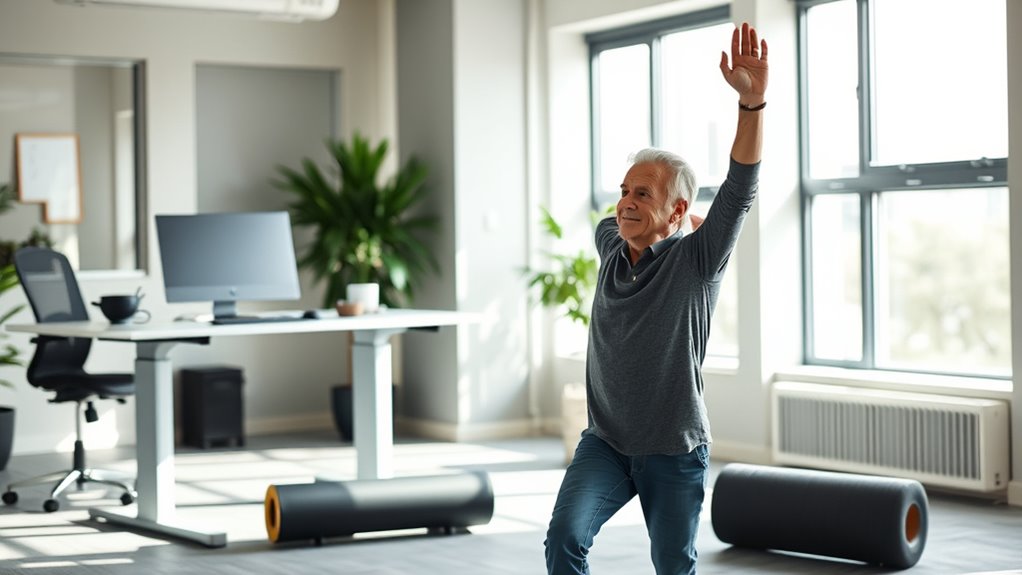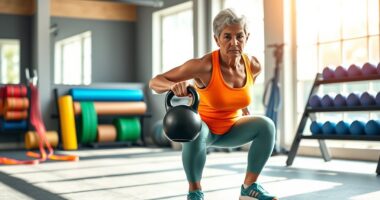To counteract a desk-bound posture, incorporate regular movement routines like neck and shoulder stretches, spinal twists, and chest openers to loosen tight muscles and improve posture. Add hip openers, leg lifts, and calf raises for lower body mobility, and include wrist and hand mobilizations to prevent tension. Quick cardio breaks, seated Cat-Cow, and side stretches boost circulation and flexibility. Keep moving consistently, and you’ll find targeted tips that can make a real difference over time.
Key Takeaways
- Incorporate regular upper back, neck, and spinal twists to improve posture and reduce muscle tension from prolonged sitting.
- Perform chest, shoulder, and arm openers like doorway stretches to counteract forward hunching.
- Include hip openers and leg mobility exercises such as lunges and leg swings to prevent lower body stiffness.
- Engage in gentle cardio and active breaks, like marching in place, to boost circulation and energy levels.
- Maintain ergonomic workstation setup and integrate daily movement routines to support flexibility and musculoskeletal health.
Stretching Your Neck and Shoulders
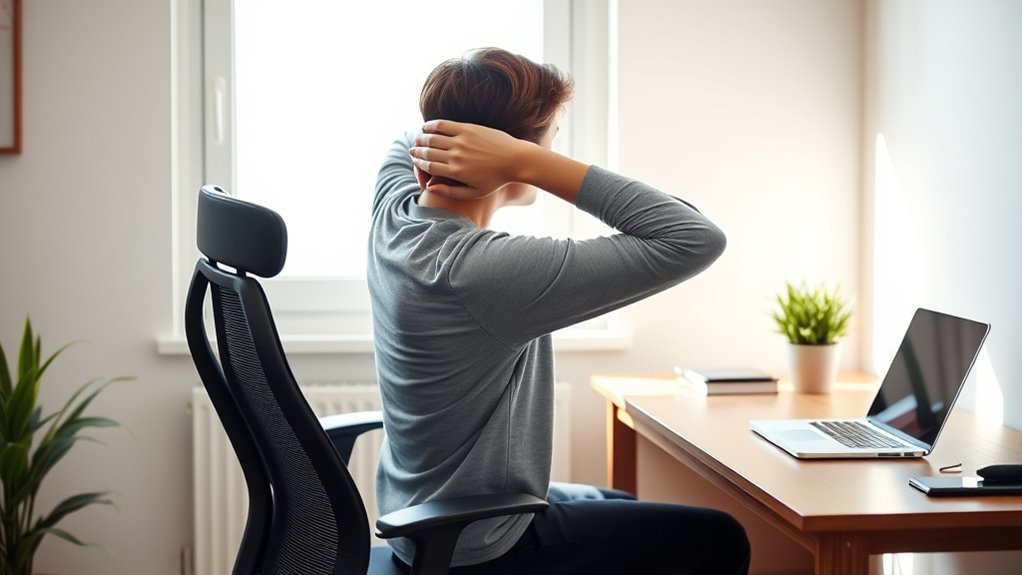
To relieve tension from prolonged sitting, it’s vital to regularly stretch your neck and shoulders. Start with simple neck stretches by gently tilting your head side to side, holding each position for a few seconds. This helps release stiffness and improves flexibility. Incorporate shoulder rolls to ease tightness; roll your shoulders forward and backward in slow, controlled motions. These movements increase circulation and reduce muscle tension caused by sitting hunched over a desk. Keep your movements smooth and deliberate, avoiding any jerky motions. Doing these stretches regularly can prevent discomfort and promote better posture. Remember, consistency is key. Incorporate neck stretches and shoulder rolls into your daily routine to counteract the effects of long hours at your desk. Embracing mindful movement can also enhance your overall attention during these exercises, making them more effective. Additionally, being aware of posture habits throughout the day can further support spinal alignment and muscle health. Practicing ergonomic adjustments at your workstation can significantly reduce strain and improve comfort. Maintaining awareness of relationships – personality test can contribute to a more holistic approach to well-being by reducing stress and promoting mental clarity. Incorporating mindful movement techniques can also help you stay present and reduce tension buildup.
Spinal Twists for Flexibility
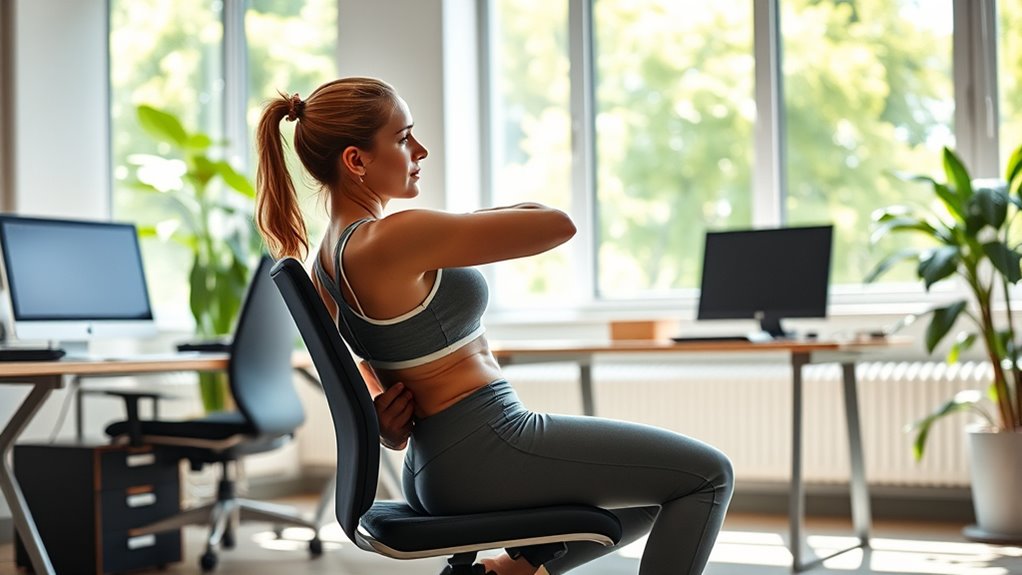
Spinal twists are a simple way to improve your flexibility and increase mobility in your back. By using gentle twist techniques, you can safely enhance spinal mobility without strain. Incorporating these moves into your routine helps counteract the effects of sitting all day. Additionally, integrating exfoliation benefits can promote a more active and engaging environment, fostering mental well-being alongside physical mobility. Selecting the right dog names can also bring joy and motivation to your daily routine, encouraging a more positive mindset. Exploring top anime movies can provide a delightful mental escape, enriching your relaxation time after stretching exercises.
Enhanced Spinal Mobility
Incorporating spinal twists into your routine can substantially enhance flexibility and reduce stiffness caused by prolonged sitting. These movements improve spinal mobility, making posture correction easier and more effective. As you perform twists, focus on maintaining proper desk ergonomics by aligning your workspace to support your movements. Twisting helps release tension in the spine, shoulders, and hips, counteracting the effects of a desk-bound routine. Regularly practicing these twists can increase your range of motion and promote better posture throughout the day. Remember to move gently, avoid forcing the stretch, and breathe deeply to maximize benefits. Enhanced spinal mobility not only alleviates discomfort but also supports overall spinal health, helping you stay comfortable and aligned during long hours at your desk. Incorporating ergonomic workspace setup and mindful decor can also contribute to a more comfortable workspace environment. Additionally, understanding alimony laws and other legal considerations related to workplace disruptions can help maintain stability and support during lifestyle changes.
Gentle Twist Techniques
Gentle twist techniques are an effective way to improve spinal flexibility without risking overstretching or discomfort. These twist exercises focus on controlled spine rotation, helping you loosen tight muscles and increase mobility. To perform a gentle twist, sit upright with your feet flat on the floor, then slowly turn your upper body to one side, using your hand on your opposite knee for support. Hold the position briefly, feeling the stretch along your spine, then switch sides. Avoid forcing the movement; the goal is smooth, manageable spine rotation that encourages flexibility without pain. Incorporate these gentle twists into your routine regularly to counteract the effects of prolonged sitting, promoting better posture and spinal health. Consistency is key for lasting benefits.
Hip Openers to Reduce Tightness
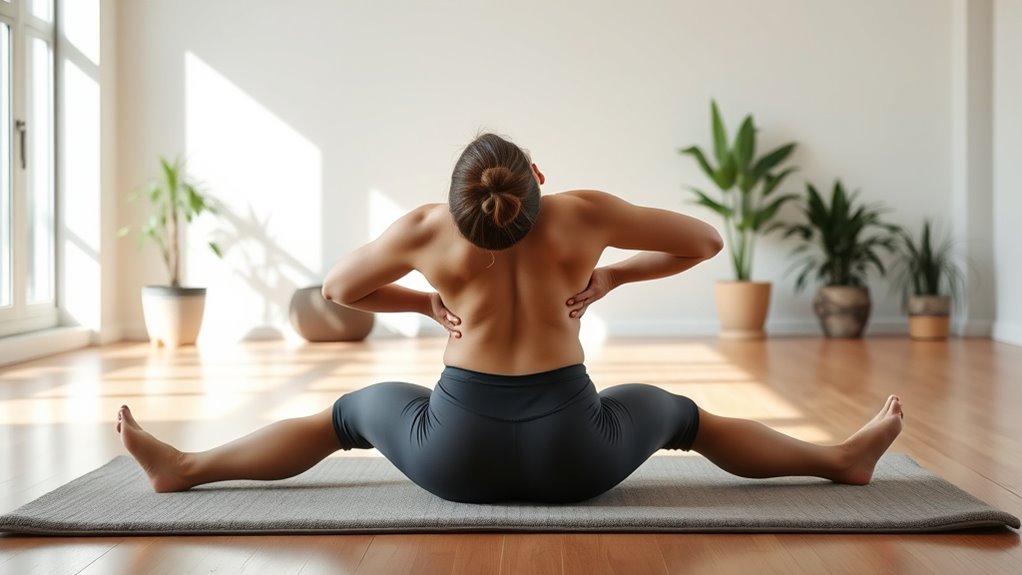
Since sitting for extended periods can cause your hips to tighten, incorporating hip openers into your routine is vital for relief. These stretches target the hip flexor muscles, which often become tight from prolonged sitting, and promote glute activation. Try kneeling lunges to stretch your hip flexors while engaging your glutes to support proper alignment. Pigeon pose is another effective move, opening up the hip joint and releasing tension. Incorporate dynamic leg swings to further loosen tight areas. Using properly connected headphones can also enhance your workout experience by allowing you to listen to guided routines or music without distraction. Regular practice helps restore mobility, reduce discomfort, and improve posture. Maintaining flexibility in your hips is essential for overall movement and preventing future tightness caused by sitting. Incorporating targeted stretching exercises can further optimize your mobility and overall well-being. Additionally, employing mindfulness and breathing techniques can help deepen your stretches and promote relaxation during your routine. AI-powered tools and insights can also assist in designing personalized stretching routines. Being aware of home cinema projector technology and its impact on visual clarity can motivate you to create a better environment for your relaxation and exercise space. Regularly adding these hip openers keeps your hips healthy and functional.
Chest and Arm Openers

Tightness in the hips from prolonged sitting can lead to poor posture and discomfort that affects other parts of your body. To counter this, focus on chest and arm openers. These movements improve flexibility, promote better breathing exercises, and support core activation. Incorporating these stretches can also help mitigate musculoskeletal issues associated with sedentary habits, enhancing overall mobility. Regularly practicing these routines can prevent postural imbalances and improve your overall well-being. Here are four effective techniques:
Prolonged sitting causes hip tightness, leading to poor posture and discomfort; try chest and arm openers to improve flexibility and mobility.
- Doorway Stretch – Stand in a doorway, place your arms on the frame, and gently lean forward to open your chest.
- Reverse Arm Circles – Extend arms behind you and make small circles to activate shoulder and back muscles.
- Thoracic Extension – Use a foam roller to gently roll along your upper back, enhancing mobility.
- Wall Angels – Press your back against the wall, raise arms, and mimic a snow angel to improve posture and flexibility. Additionally, incorporating proper ergonomic practices during your workday can further support your mobility and posture health. Being aware of RMDs and beneficiary designations can also promote long-term retirement security.
Leg Extensions and Calf Raises
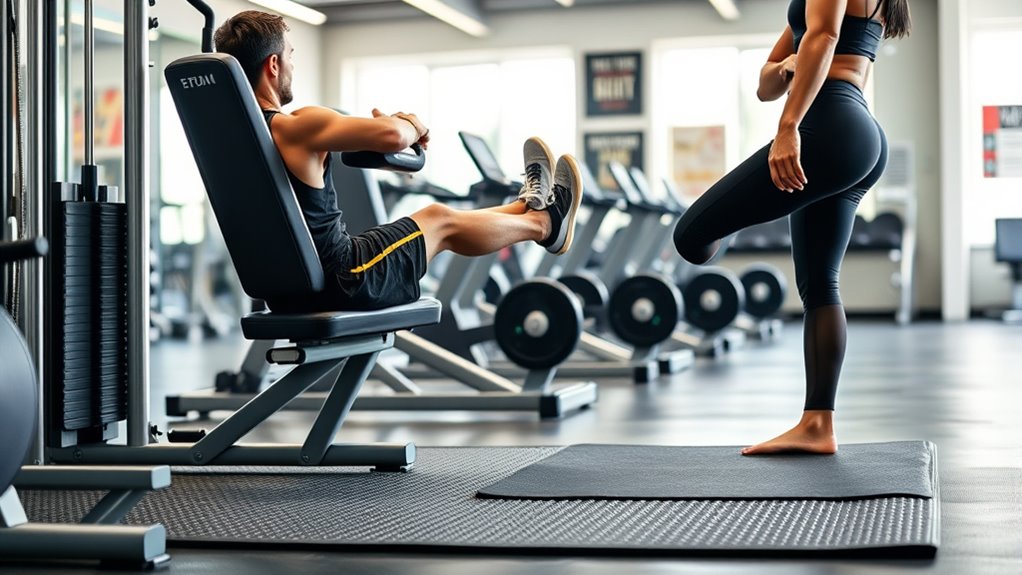
To get the most out of leg extensions and calf raises, focus on maintaining proper form and technique. Doing these exercises correctly helps prevent injury and maximizes their benefits. When performed well, they effectively strengthen your lower legs and improve overall stability. Additionally, incorporating self-watering plant pots can help keep your environment healthy and stress-free, supporting your fitness routine. Staying aware of AI vulnerabilities and adopting safe practices can also contribute to a more secure and resilient fitness environment. Being mindful of regional legal resources can provide valuable guidance if you face challenges related to injury or training disputes.
Proper Form and Technique
Proper form and technique are essential when performing leg extensions and calf raises to maximize effectiveness and prevent injury. Maintaining correct posture ensures you’re engaging the right muscles and avoiding strain. Use ergonomic accessories, like supportive mats or adjustable seating, to improve stability and posture correction during exercises. Focus on controlled movements, avoiding momentum, and keep your core engaged. Here are key tips:
- Keep your back straight and shoulders relaxed.
- Move through full, controlled ranges of motion.
- Avoid locking your knees at the top of extensions or raises.
- Use appropriate resistance levels to challenge without compromising form.
Benefits of Leg Raises
Incorporating leg raises like leg extensions and calf raises into your routine can deliver significant health and fitness benefits. These exercises help build leg strength, making daily movements easier and reducing injury risk. They also promote a circulation boost, which is essential for preventing stiffness and swelling caused by prolonged sitting. Leg extensions specifically target your quadriceps, improving muscle endurance and joint stability. Calf raises strengthen your calves and enhance ankle stability, supporting better balance. Regularly performing these exercises can improve overall mobility, helping you counteract the effects of a desk-bound posture. Plus, they’re easy to do anywhere, requiring minimal equipment. Consistent leg raises not only boost your muscular health but also contribute to better circulation, keeping your legs energized and healthy throughout the day.
Wrist and Hand Mobilizations

Wrist and hand mobilizations are essential for relieving tension and preventing stiffness caused by prolonged typing or mouse use. Regular movements help maintain flexibility and reduce discomfort, especially if you use an ergonomic keyboard or wear wrist splints. Incorporate these techniques:
- Rotate your wrists in slow circles, five times each direction.
- Stretch fingers wide, then relax them repeatedly.
- Gently bend your wrists forward and backward, holding each position for 10 seconds.
- Use gentle finger taps to stimulate circulation.
These exercises can be done throughout the day to counteract the effects of sustained static postures. Taking frequent breaks to mobilize your wrists and hands helps prevent overuse injuries and keeps your grip strong and responsive. Remember, consistent mobility routines are key to maintaining comfort and function.
Gentle Cardio to Boost Circulation
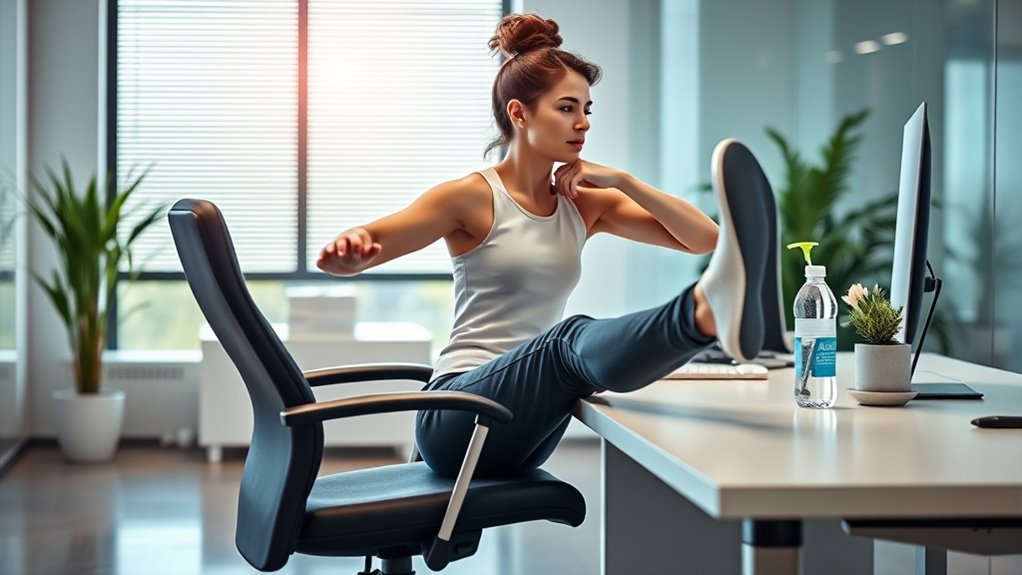
Moving your body gently throughout the day can substantially enhance circulation and reduce the stiffness caused by prolonged sitting. Incorporate light cardio exercises, such as marching in place or brisk walking during breaks, to keep blood flowing. Proper desk ergonomics and workstation adjustments help facilitate movement without straining your body. Adjust your chair height to ensure your feet are flat on the ground, and keep your monitor at eye level to prevent neck strain. These small changes make it easier to stand, stretch, or walk briefly, promoting circulation. Even a few minutes of brisk activity every hour breaks up sitting time and boosts energy. Keep mobility routines simple and consistent to counteract the effects of a desk-bound posture effectively.
Seated Cat-Cow Movements
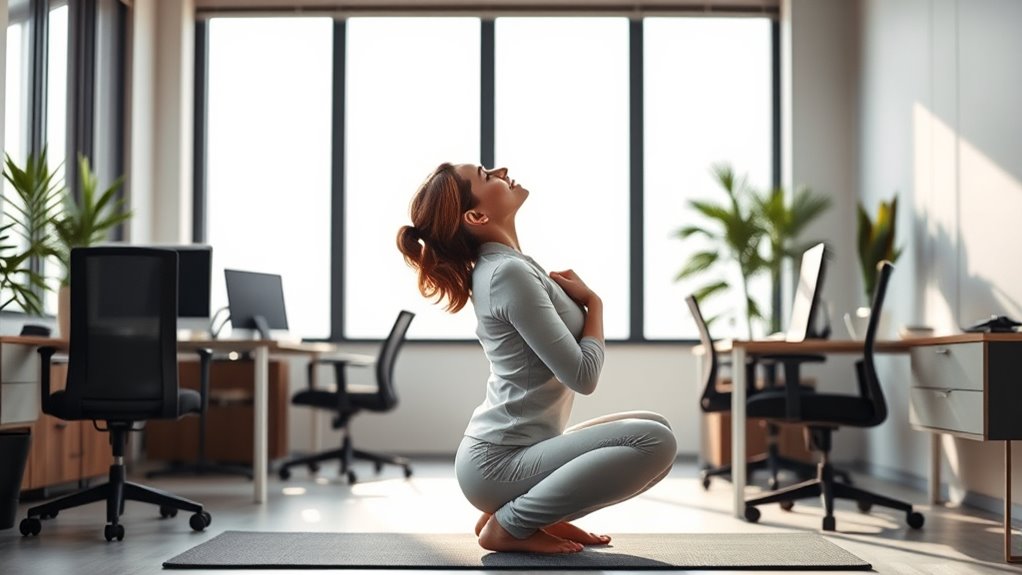
Seated Cat-Cow movements are an effective way to gently stretch your spine and improve flexibility while at your desk. They promote posture correction by mobilizing your vertebrae and easing tension caused by prolonged sitting. To maximize benefits, consider using ergonomic accessories like a supportive chair or lumbar roll. Follow these steps:
- Sit upright, hands on your knees, feet flat on the floor.
- Inhale, arch your back, lift your chest, and look upward (Cow pose).
- Exhale, round your spine, tuck your chin toward your chest (Cat pose).
- Repeat slowly for 8–10 cycles, focusing on smooth, controlled movements.
Incorporating these movements regularly can help counteract desk-bound postures and enhance overall spinal health.
Standing Back Bends and Side Stretches
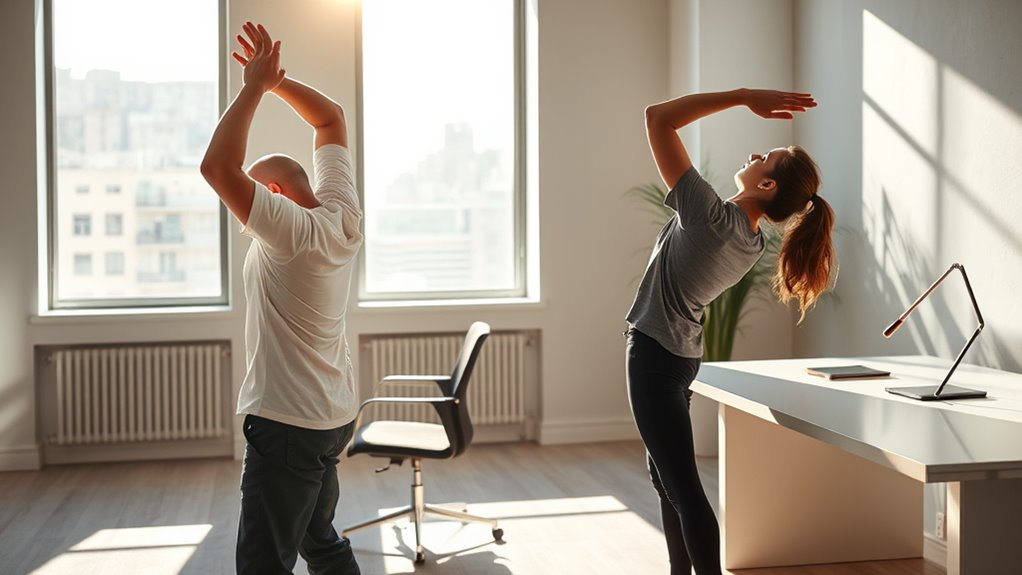
Standing back bends and side stretches are excellent moves to counteract stiffness from prolonged sitting and improve overall flexibility. These stretches target your spine and sides, helping to relieve tension caused by an ergonomic desk setup. By incorporating standing back bends, you open up your chest and strengthen your back muscles, which can often become tight from slouching. Side stretches loosen the muscles along your ribs and obliques, promoting better posture and breathing. Using a standing desk benefits your mobility routines by allowing easier movement and reducing pressure on your lower back. Incorporate these stretches into your daily routine to counteract desk-bound posture, enhance your flexibility, and experience the full benefits of an ergonomic work environment. They’re simple, effective, and crucial for maintaining your mobility.
Frequently Asked Questions
How Often Should I Perform These Mobility Routines Daily?
You’re wondering how often you should do these routines daily. To combat a desk-bound posture, aim for exercise frequency of about every 30 to 60 minutes during your workday. Keep your routine duration around 5 to 10 minutes to stay effective without causing fatigue. Regular movement helps improve flexibility and reduce discomfort, so make it a habit to stretch or do mobility exercises frequently throughout the day for best results.
Are There Any Precautions for Beginners With Limited Flexibility?
As a beginner, it’s smart to start with a flexibility assessment to understand your limits. You should incorporate beginner modifications, like gentle stretches and shorter routines, to prevent overstretching or injury. Always listen to your body and avoid pushing too hard. Gradually increase intensity as your flexibility improves, and consider consulting a professional for personalized guidance. This guarantees safe progress and helps build your mobility confidently.
Can These Exercises Prevent Chronic Back or Neck Pain?
Yes, incorporating mobility exercises can help prevent chronic back and neck pain by improving posture and flexibility. Make ergonomic adjustments to your workspace to support proper alignment, and include these exercises regularly. Not only do they reduce pain, but they also offer mental health benefits by decreasing stress and boosting your mood. Staying consistent with these routines helps you maintain a healthier, more comfortable work environment.
What Equipment, if Any, Is Necessary for These Routines?
For these routines, you mainly need ergonomic tools and stretching bands. Ergonomic tools like adjustable chairs and sit-stand desks help support proper posture. Stretching bands assist in deepening stretches and improving flexibility. You don’t require complex equipment—simple, accessible tools make a big difference. With ergonomic tools and stretching bands, you can enhance your mobility, reduce discomfort, and maintain a healthier, more comfortable desk-bound routine each day.
How Long Should Each Session Take to Be Effective?
For each session, aim for 10 to 15 minutes to guarantee effectiveness. Duration guidelines suggest short, frequent breaks work best to counteract a desk-bound posture. You’ll boost mobility and reduce discomfort more effectively with consistent routines. Remember, effectiveness factors include maintaining proper form and staying active throughout the day. Regular, manageable sessions make it easier to stay committed and see lasting improvements in your posture and overall comfort.
Conclusion
Keep moving throughout your day, and don’t let stiffness take over. These simple routines can transform your posture and boost your energy—if you stay consistent. But the real change happens when you make mobility a habit. Will you notice the difference tomorrow? Or will it take a few days? The choice is yours. Start today, and see how small movements can release a healthier, more flexible you—just one stretch at a time.
